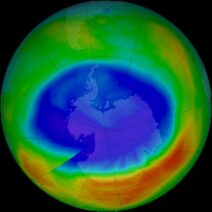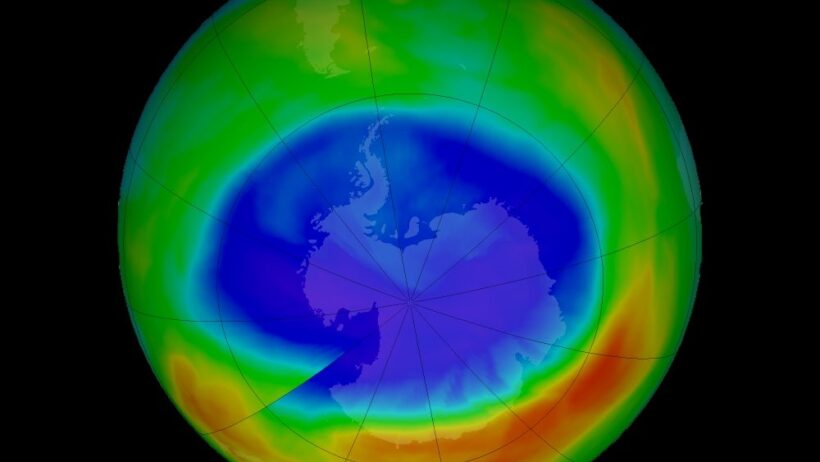Understanding the intricate relationship between the ozone hole and global warming is essential for tackling climate change in an informed manner. This discussion will dissect both phenomena, elucidate their differences, and scrutinize the myths surrounding their interactions.
To commence, it is crucial to define what the ozone hole is. The ozone hole refers to a significant depletion of the ozone layer, predominantly over Antarctica, resulting from the release of chlorofluorocarbons (CFCs) and other ozone-depleting substances. This phenomenon is marked by an annual thinning of the ozone layer, which allows increased ultraviolet (UV) radiation to reach the Earth’s surface. The effects of higher UV levels are numerous, ranging from increased risks of skin cancer in humans to detrimental impacts on various ecosystems.
Simultaneously, global warming refers to the ongoing increase in Earth’s average surface temperature, primarily driven by anthropogenic greenhouse gas emissions. Carbon dioxide (CO2), methane (CH4), and nitrous oxide (N2O) are the principal culprits of this warming. While the ozone hole and global warming are both issues emanating from human activity, they are not directly interlinked in terms of causation.
One of the earliest misconceptions is that the ozone hole contributes directly to global warming. Consequently, it is critical to clarify that the depletion of the ozone layer and the greenhouse effect operate through disparate mechanisms. The greenhouse gases trap heat in the atmosphere, resulting in higher global temperatures. In contrast, the ozone layer protects life on Earth from harmful UV radiation, without significantly influencing the greenhouse effect. Therefore, while both phenomena result from human interventions, they exist independently of one another.
Considering the geographical aspect, the ozone hole predominantly exists over the polar regions, specifically Antarctica. In contrast, the most pronounced effects of global warming are experienced globally, impacting diverse biomes and ecosystems. For instance, rising temperatures lead to ice melt in the Arctic and sea-level rise affecting coastal communities worldwide. This geographic disparity indicates that while both issues stem from human activity, their impacts and operational zones vary significantly.
Furthermore, scientists have noted some indirect effects stemming from the relationship between the ozone hole and climate change. For instance, changes in the ozone layer can influence atmospheric circulation patterns, possibly leading to alterations in weather systems. Increased UV radiation from an enlarged ozone hole can affect weather patterns, possibly resulting in colder or warmer temperatures in specific regions. Nonetheless, these are correlative phenomena rather than direct causal links, emphasizing the importance of distinguishing between correlation and causation in scientific discussions.
Another vital aspect to consider is the interplay between climate change and ozone-depleting substances. The 1987 Montreal Protocol emerged as a pioneering international treaty aimed at phasing out substances responsible for ozone depletion. This protocol is widely regarded as a success story in environmental governance. With reduced CFC emissions, scientists have observed signs of recovery in the ozone layer. However, many of the strategies employed to combat greenhouse gas emissions are distinct from those targeting ozone-depleting substances. As such, a comprehensive strategy must be employed, focusing on addressing both climate change and ozone depletion simultaneously.
Additionally, the phasing out of CFCs had unintended benefits for climate change mitigation. CFCs are potent greenhouse gases, with a global warming potential thousands of times greater than that of CO2. Therefore, the reduction of CFC emissions has had a dual impact—facilitating ozone recovery while inadvertently aiding the global effort to curtail warming. Nevertheless, the prevention of ozone depletion alone cannot resolve climate change. Comprehensive strategies encompassing all greenhouse gas emissions must be employed.
Furthermore, it is essential to address the misconception that recovery of the ozone layer will inherently resolve global warming issues. While the gradual healing of the ozone layer is promising, it is imperative to recognize that the primary drivers of global warming reside within carbon emissions and other greenhouse gases. Future climate strategies should incorporate sustainable practices, promoting renewable energy, carbon capture technologies, and reforestation, as these actions directly address the root causes of global warming.
It is also pertinent to highlight the importance of public awareness and scientific literacy in fostering meaningful climate change conversations. Many individuals conflating ozone layer degradation with global warming highlight a gap in understanding fundamental environmental science. Educational initiatives must focus on elucidating these topics, empowering communities to engage in informed discourse. Public awareness campaigns can also encourage collective action, ultimately leading to more robust and effective climate policies.
Finally, in conclusion, while the ozone hole and global warming both stem from anthropogenic actions and have overlapping concerns regarding environmental integrity, they function through different mechanisms and are not causatively related. The success of international treaties such as the Montreal Protocol serves as a reminder that coordinated global action can yield significant environmental benefits. However, the fight against climate change must persist through innovative measures aimed directly at greenhouse gas emissions. A comprehensive approach addressing both climate change and ozone depletion is not merely prudent; it is necessary for the preservation of our planet’s delicate balance.
In summary, separating fact from fiction regarding the ozone hole and global warming enriches our understanding of environmental issues. Accurate information equips us with the tools necessary to combat climate change effectively and protect our planet for future generations.






